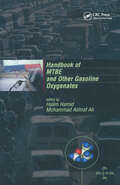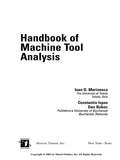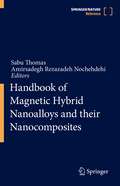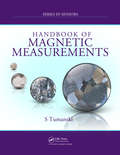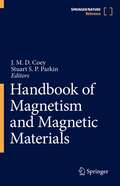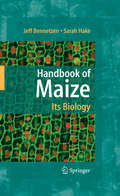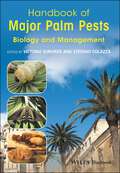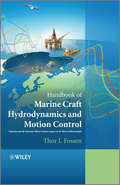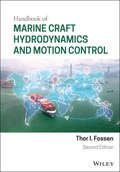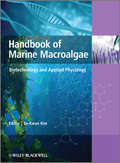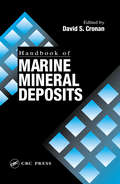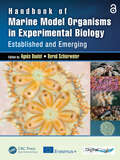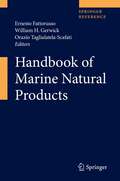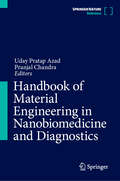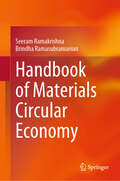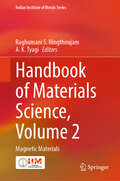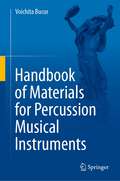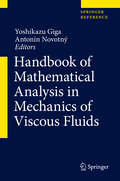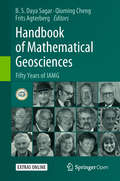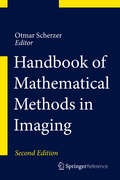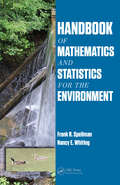- Table View
- List View
Handbook of MTBE and Other Gasoline Oxygenates
by Halim Hamid Mohammad Ashraf AliThis handbook presents the outlook for future production and consumption of MTBE and other oxygenates worldwide and studies new catalytic systems and modern methods for the synthesis and commercial production of methyl tertiary-butyl ether (MTBE) and related ethers. The scope of this sophisticated guide extends from process chemistry fundamentals a
Handbook of Machine Learning Applications for Genomics (Studies in Big Data #103)
by Sanjiban Sekhar Roy Y. H. TaguchiCurrently, machine learning is playing a pivotal role in the progress of genomics. The applications of machine learning are helping all to understand the emerging trends and the future scope of genomics. This book provides comprehensive coverage of machine learning applications such as DNN, CNN, and RNN, for predicting the sequence of DNA and RNA binding proteins, expression of the gene, and splicing control. In addition, the book addresses the effect of multiomics data analysis of cancers using tensor decomposition, machine learning techniques for protein engineering, CNN applications on genomics, challenges of long noncoding RNAs in human disease diagnosis, and how machine learning can be used as a tool to shape the future of medicine. More importantly, it gives a comparative analysis and validates the outcomes of machine learning methods on genomic data to the functional laboratory tests or by formal clinical assessment. The topics of this book will cater interest to academicians, practitioners working in the field of functional genomics, and machine learning. Also, this book shall guide comprehensively the graduate, postgraduates, and Ph.D. scholars working in these fields.
Handbook of Machine Tool Analysis
by Ioan D. Marinescu Constantin Ispas Dan BobocWritten by seasoned experts in the field, this reference explores efficient methods of design, structural analysis, and algorithm formulation to: reduce waste, noise, and breakage in system function; identify faults in system construction; and achieve optimal machine tool performance. The authors investigate issues such as force, noise, vibration,
Handbook of Magnetic Hybrid Nanoalloys and their Nanocomposites
by Sabu Thomas Amirsadegh Rezazadeh NochehdehiThis comprehensive reference work satisfies the need for in-depth and multidisciplinary coverage of the current state of the art of magnetic hybrid nanoalloys (MHNAs) and their polymer and ceramic nanocomposites. MHNAs represent one of the most challenging research areas in modern science and technology. These materials are stiff and strong with remarkable electronic, mechanical, electrical, thermal and biocompatible properties, and a high potential for multifunctional applications ranging from industry to medicine. The peer-reviewed literature is already extensive, witnessing rapid progress in experimental and theoretical studies on fundamental properties as well as various advanced applications. Part 1 covers theory, modelling, and synthesis (growth and alloying mechanisms) of MHNAs. Formation mechanisms of magneto-electric multiferroic materials, magnetic carbon nanotube (CNTs), and perovskite materials, which are a novel class of next-generation multifunctional nanomaterials, are discussed. The second part focuses on characterization techniques for electrical and dielectrical, rheological, biocompatibility, and other properties, as well as applications in the industrial, agricultural, environmental, and biomedical sectors. Finally, life cycle assessment is considered as essential to the development of nanomaterials and nanoproducts from MHNAs. Advanced undergraduate and graduate students, researchers, and other professionals in the fields of materials science and engineering, polymer science, surface science, bioengineering, and chemical engineering will find comprehensive and authoritative information for solving fundamental and applied problems in the characterization and use of these multifunctional nanomaterials.
Handbook of Magnetic Measurements (ISSN)
by Slawomir TumanskiCollecting state-of-the-art knowledge from information scattered throughout the literature, this handbook describes magnetic materials and sensors, the testing of magnetic materials, and applications of magnetic measurements. It presents an up-to-date, accessible account of modern magnetic measurement techniques. The book discusses the fundamentals of magnetism and covers contemporary magnetic materials and sensors. It also explores applications of magnetic diagnostics in medicine, magnetoarcheology, and magnetic imaging. An extensive list of references is included at the end of each chapter.
Handbook of Magnetism and Magnetic Materials
by J. M. D. Coey Stuart S. P. ParkinThis handbook presents a comprehensive survey of magnetism and magnetic materials. The dramatic advances in information technology and electromagnetic engineering make it necessary to systematically review the approved key knowledge and summarize the state of the art in this vast field within one seminal reference work. The book thus delivers up-to-date and well-structured information on a wealth of topics encompassing all fundamental aspects of the underlying physics and materials science, as well as advanced experimental methodology and applications. It features coverage of the host of fascinating and complex phenomena that arise from the use of magnetic fields in e.g. chemistry and biology. Edited by two internationally renowned scholars and featuring authored chapters from leading experts in the field, Springer’s Handbook of Magnetism and Magnetic Materials is an invaluable source of essential reference information for a broad audience of students, researchers, and magnetism professionals.
Handbook of Maize: Its Biology
by Jeff L. Bennetzen Sarah C. HakeHandbook of Maize: Its Biology centers on the past, present and future of maize as a model for plant science research and crop improvement. The book includes brief, focused chapters from the foremost maize experts and features a succinct collection of informative images representing the maize germplasm collection.
Handbook of Major Palm Pests: Biology and Management
by Stefano Colazza Victoria SorokerHandbook of Major Palm Pests: Biology and Management contains the most comprehensive and up-to-date information on the red palm weevil and the palm borer moth, two newly emergent invasive palm pests which are adversely affecting palm trees around the world. It provides state-of-the-art scientific information on the ecology, biology, and management of palm pests from a global group of experts in the field.An essential compendium for anyone working with or studying palms, it is dedicated to the detection, eradication, and containment of these invasive species, which threaten the health and very existence of global palm crops.
Handbook of Marine Craft Hydrodynamics and Motion Control
by Thor I. FossenThe technology of hydrodynamic modeling and marine craft motion control systems has progressed greatly in recent years. This timely survey includes the latest tools for analysis and design of advanced guidance, navigation and control systems and presents new material on underwater vehicles and surface vessels. Each section presents numerous case studies and applications, providing a practical understanding of how model-based motion control systems are designed.Key features include:a three-part structure covering Modeling of Marine Craft; Guidance, Navigation and Control Systems; and Appendices, providing all the supporting theory in a single resourcekinematics, kinetics, hydrostatics, seakeeping and maneuvering theory, and simulation models for marine craft and environmental forces guidance systems, sensor fusion and integrated navigation systems, inertial measurement units, Kalman filtering and nonlinear observer design for marine craftstate-of-the-art methods for feedback controlmore advanced methods using nonlinear theory, enabling the user to compare linear design techniques before a final implementation is made.linear and nonlinear stability theory, and numerical methods companion website that hosts links to lecture notes and download information for the Marine Systems Simulator (MSS) which is an open source Matlab/Simulink® toolbox for marine systems. The MSS toolbox includes hydrodynamic models and motion control systems for ships, underwater vehicles and floating structuresWith an appropriate balance between mathematical theory and practical applications, academic and industrial researchers working in marine and control engineering aspects of manned and unmanned maritime vehicles will benefit from this comprehensive handbook. It is also suitable for final year undergraduates and postgraduates, lecturers, development officers, and practitioners in the areas of rigid-body modeling, hydrodynamics, simulation of marine craft, control and estimation theory, decision-support systems and sensor fusion. www.wiley.com/go/fossen_marine
Handbook of Marine Craft Hydrodynamics and Motion Control
by Thor I. FossenHandbook of MARINE CRAFT HYDRODYNAMICS AND MOTION CONTROL The latest tools for analysis and design of advanced GNC systemsHandbook of Marine Craft Hydrodynamics and Motion Control is an extensive study of the latest research in hydrodynamics, guidance, navigation, and control systems for marine craft. The text establishes how the implementation of mathematical models and modern control theory can be used for simulation and verification of control systems, decision-support systems, and situational awareness systems. Coverage includes hydrodynamic models for marine craft, models for wind, waves and ocean currents, dynamics and stability of marine craft, advanced guidance principles, sensor fusion, and inertial navigation.This important book includes the latest tools for analysis and design of advanced GNC systems and presents new material on unmanned underwater vehicles, surface craft, and autonomous vehicles. References and examples are included to enable engineers to analyze existing projects before making their own designs, as well as MATLAB scripts for hands-on software development and testing. Highlights of this Second Edition include:Topical case studies and worked examples demonstrating how you can apply modeling and control design techniques to your own designsA Github repository with MATLAB scripts (MSS toolbox) compatible with the latest software releases from MathworksNew content on mathematical modeling, including models for ships and underwater vehicles, hydrostatics, and control forces and momentsNew methods for guidance and navigation, including line-of-sight (LOS) guidance laws for path following, sensory systems, model-based navigation systems, and inertial navigation systemsThis fully revised Second Edition includes innovative research in hydrodynamics and GNC systems for marine craft, from ships to autonomous vehicles operating on the surface and under water. Handbook of Marine Craft Hydrodynamics and Motion Control is a must-have for students and engineers working with unmanned systems, field robots, autonomous vehicles, and ships.MSS toolbox: https://github.com/cybergalactic/mssLecture notes: https://www.fossen.biz/wileyAuthor’s home page: https://www.fossen.biz
Handbook of Marine Macroalgae
by Se-Kwon KimThe Handbook of Macroalgae: Biotechnology and Applied Phycology describes the biological, biotechnological and the industrial applications of seaweeds. Vast research into the cultivation of seaweeds is currently being undertaken but there is a lack of methodological strategies in place to develop novel drugs from these sources. This book aims to rectify this situation, providing an important review of recent advances and potential new applications for macroalgae. Focusing on the chemical and structural nature of seaweeds the book brings the potentially valuable bioactive nature to the fore. Novel compounds isolated from seaweeds are reviewed to provide an invaluable reference for anyone working in the field.
Handbook of Marine Mineral Deposits
by David S. Cronan D. Sc. FimmThis handbook summarizes the main advances in our understanding of marine minerals and concentrates on the deposits of proven economic potential. In cases where our knowledge may be too limited to allow defining of their economic potential, those minerals are covered regionally or by deposit type. Handbook of Marine Mineral Deposits is divided into three sections; Marine placers, manganese nodules and crusts, and deep-sea hydrothermal mineralization. All of these mineral deposits have great potential importance to economic geologists and marine mines.Edited by an acknowledged expert in the field, this handbook includes work by internationally renowned contributors. The new United Nations Law of the Sea, ratified by over 100 countries within the past two years, provides a framework and guidelines for deep-sea mineral exploration that increases international interest in this book. The Handbook serves as a platform from which to launch the more detailed evaluation studies that will need to take place in the 21st century before recovery can continue or commence. Handbook of Marine Mineral Deposits is useful to mineralogists, economic geologists, marine geologists, marine miners, and conservationists.Features
Handbook of Marine Model Organisms in Experimental Biology: Established and Emerging
by Bernd Schierwater Agnès BoutetThe importance of molecular approaches for comparative biology and the rapid development of new molecular tools is unprecedented. The extraordinary molecular progress belies the need for understanding the development and basic biology of whole organisms. Vigorous international efforts to train the next-generation of experimental biologists must combine both levels – next generation molecular approaches and traditional organismal biology. This book provides cutting-edge chapters regarding the growing list of marine model organisms. Access to and practical advice on these model organisms have become a conditio sine qua non for a modern education of advanced undergraduate students, graduate students and postdocs working on marine model systems. Model organisms are not only tools they are also bridges between fields – from behavior, development and physiology to functional genomics. Key Features Offers deep insights into cutting-edge model system science Provides in-depth overviews of all prominent marine model organisms Illustrates challenging experimental approaches to model system research Serves as a reference book also for next-generation functional genomics applications Fills an urgent need for students Related Titles Jarret, R. L. & K. McCluskey, eds. The Biological Resources of Model Organisms (ISBN 978-1-1382-9461-5) Kim, S.-K. Healthcare Using Marine Organisms (ISBN 978-1-1382-9538-4) Mudher, A. & T. Newman, eds. Drosophila: A Toolbox for the Study of Neurodegenerative Disease (ISBN 978-0-4154-1185-1) Green, S. L. The Laboratory Xenopus sp. (ISBN 978-1-4200-9109-0)
Handbook of Marine Natural Products
by Ernesto Fattorusso Orazio Taglialatela-Scafati William H. Gerwick"Handbook of Marine Natural Products" takes a fresh approach to describing the major themes of research in this rapidly developing field. This two volume reference work begins with a section that provides a taxonomic survey of the secondary metabolites of diverse marine life including microbes, algae, and invertebrates. This is followed by a demonstration of the techniques and strategies employed in modern structure elucidation of complex natural products. The natural roles of marine natural products are then explored in a series of focused chapters which include the topics of symbiosis, anti-predation and antifouling, chemical interactions, and defence against UV stress. Various routes which facilitate the understanding of marine natural product biosynthesis are subsequently explained and these are followed by an extensive set of chapters on the biomedical potential of marine natural products. The latter portion of this section considers the technologies and scientific disciplines necessary for advancing bioactive marine natural product lead compounds into actual pharmaceuticals. The reference work finishes with a selection of chapters describing marine toxins and their impact on public health and seafood resources. Final thoughts presented at the end of the second volume focus on the future of this field of investigation and discovery research. This publication is presented as a reference handbook and general concepts are emphasized and illustrated with numerous interesting examples, graphical information, and a comprehensive index. "Handbook of Marine Natural Products" introduces students who are at advanced undergraduate and entry graduate student levels to this fascinating multidisciplinary field. It is an ideal desk companion for courses focusing on this contemporary area.
Handbook of Mass Measurement
by Frank E. Jones Randall M. Schoonover"How much does it weigh?" seems a simple question. To scientists and engineers, however, the answer is far from simple, and determining the answer demands consideration of an almost overwhelming number of factors.With an intriguing blend of history, fundamentals, and technical details, the Handbook of Mass Measurement sets forth the details
Handbook of Material Engineering in Nanobiomedicine and Diagnostics
by Pranjal Chandra Uday Pratap AzadThe book is about the application of nanotechnology in the field of medicine, with a focus on diagnosis and therapy. The first few chapters introduce the basics of material engineering and nanobiomedicine, followed by chapters on different types of engineered nanomaterials and their surface modification strategies for biomedicine. The book then covers the application of nanobiomedicines and nanodiagnostics in clinical settings, and how functionalized nanomaterials can be used in microfluidic biosensors and diagnosis devices. The latter half of the book discusses various nanobiomaterials used in cancer diagnosis and therapy, as well as regenerative medicine, infectious diseases, and bioimaging. The book concludes with a chapter on the commercial aspects of nanobiomedicines.
Handbook of Material Flow Analysis: For Environmental, Resource, and Waste Engineers, Second Edition (Advanced Methods In Resource And Waste Management Ser.)
by Paul H. Brunner Helmut RechbergerIn this second edition of a bestseller, authors Paul H. Brunner and Helmut Rechberger guide professional newcomers as well as experienced engineers and scientists towards mastering the art of material flow analysis (MFA) from the very beginning to an advanced state of material balances of complex systems. Handbook of Material Flow Analysis: For Environmental, Resource, and Waste Engineers, Second Edition serves as a concise and reproducible methodology as well as a basis for analysis, assessment and improvement of anthropogenic systems through an approach that is helpfully uniform and standardized. The methodology featured in this book is a vital resource for generating new data, fostering understanding, and increasing knowledge to benefit the growing MFA community working in the fields of industrial ecology, resource management, waste management, and environmental protection. This new second edition takes into account all new developments and readers will profit from a new exploration of STAN software, newly added citations, and thoroughly described case studies that reveal the potential of MFA to solve industrial ecology challenges.
Handbook of Materials Circular Economy
by Seeram Ramakrishna Brindha RamasubramanianThis book provides comprehensive and practical information on the design and implementation of circular systems for various industries, with a focus on Environmental, Social, and Governance (ESG) factors. The scope of the handbook is to cover the materials circularity in a deeper analysis in accordance to ESG used in various industries such as oil and gas, IT, electronics, medicine, textile, and more. The handbook also covers the key principles of the circular economy, including material efficiency, resource conservation, and waste reduction, and how they impact to different industries. It further critically analyses the challenges and opportunities associated with implementing circular systems in these industries, including the framework for new business models and technical innovations, and the potential benefits in terms of environmental protection, social responsibility, and economic competitiveness. In addition to providing practical information, the handbookalso addresses the ESG factors associated with the circular economy exclusively for each industry. This would include the impact of circular systems on the environment, including the reduction of greenhouse gas emissions and the protection of biodiversity, as well as the social benefits, such as job creation, and the economic benefits, such as cost savings and increased competitiveness. The ultimate goal of the handbook should be to provide guidance and support in a niche evaluation for the development of a more sustainable and equitable future, where the circular economy is a key enabler.
Handbook of Materials Science, Volume 2: Magnetic Materials (Indian Institute of Metals Series)
by A. K. Tyagi Raghumani S. NingthoujamThis book presents state-of-the-art coverage of the basic concepts of magnetization. The book focuses on electron-spin interaction, electron-spin-magnetic field interactions with or without angular dependent, magnetic properties with the dimension of particles or surrounding environment, proximity effects on core-shell structure or hybrid or composite and their applications. It also discusses recent advances in magnetic materials and its future scope. This book is of interest to students, researchers and professionals working in the area of materials science, especially magnetic materials and allied fields.
Handbook of Materials Selection for Engineering Applications
by G. T. MurrayReflecting the rapid advances in new materials development, this work offers up-to-date information on the properties and applications of various classes of metals, polymers, ceramics and composites. It aims to simplify the materials selection process and show how to lower materials and manufacturing costs, drawing on such sources as vendor supplie
Handbook of Materials for Percussion Musical Instruments
by Voichita BucurThis book describes the properties of materials used for making percussion instruments for classical music played by a symphony orchestra in which the instruments could be played as a soloist instrument or as a group or several groups of instruments, as they are included into a musical work. A chapter is devoted to the bells. The scope of this book is primarily confined to percussion instruments of symphony orchestras taking into account the centuries of musical art and tradition. This book bridges the gap in the technical literature on describing the properties of materials for percussion instruments—timpani, other drums, marimba, xylophone, vibraphone, gong, cymbal, triangle, celesta, castanets.
Handbook of Mathematical Analysis in Mechanics of Viscous Fluids
by Yoshikazu Giga Antonín NovotnýMathematics has always played a key role for researches in fluid mechanics. The purpose of this handbook is to give an overview of items that are key to handling problems in fluid mechanics. Since the field of fluid mechanics is huge, it is almost impossible to cover many topics. In this handbook, we focus on mathematical analysis on viscous Newtonian fluid. The first part is devoted to mathematical analysis on incompressible fluids while part 2 is devoted to compressible fluids.
Handbook of Mathematical Geosciences: Fifty Years of IAMG
by Frits Agterberg B.S. Daya Sagar Qiuming ChengThis Open Access handbook published at the IAMG's 50th anniversary, presents a compilation of invited path-breaking research contributions by award-winning geoscientists who have been instrumental in shaping the IAMG. It contains 45 chapters that are categorized broadly into five parts (i) theory, (ii) general applications, (iii) exploration and resource estimation, (iv) reviews, and (v) reminiscences covering related topics like mathematical geosciences, mathematical morphology, geostatistics, fractals and multifractals, spatial statistics, multipoint geostatistics, compositional data analysis, informatics, geocomputation, numerical methods, and chaos theory in the geosciences.
Handbook of Mathematical Methods in Imaging
by Otmar ScherzerThe Handbook of Mathematical Methods in Imaging provides a comprehensive treatment of the mathematical techniques used in imaging science. The material is grouped into two central themes, namely, Inverse Problems (Algorithmic Reconstruction) and Signal and Image Processing. Each section within the themes covers applications (modeling), mathematics, numerical methods (using a case example) and open questions. Written by experts in the area, the presentation is mathematically rigorous. The entries are cross-referenced for easy navigation through connected topics. Available in both print and electronic forms, the handbook is enhanced by more than 150 illustrations and an extended bibliography. It will benefit students, scientists and researchers in applied mathematics. Engineers and computer scientists working in imaging will also find this handbook useful.
Handbook of Mathematics and Statistics for the Environment
by Frank R. Spellman Nancy E. WhitingA thorough revision of the previous "Environmental Engineer's Mathematics Handbook," this book offers readers an unusual approach to presenting environmental math concepts, emphasizing the relationship between the principles in natural processes and environmental processes. It integrates the fundamental math operations performed by environmental pr
